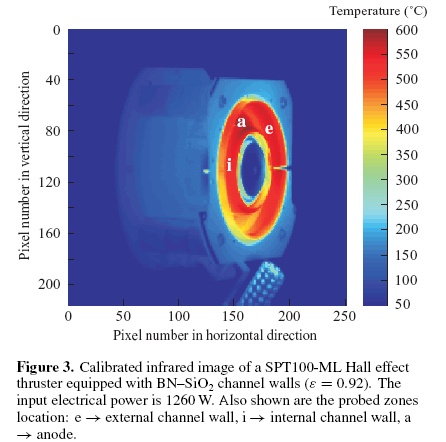Ask for a reprint
email :
* Give your email
2007
ACL
|
S.Mazouffre, P.Echegut, M.Dudeck, 'A calibrated infrared imaging study on the steady state thermal behaviour of Hall effect thrusters', Plasma Sources Science and Technology 16 13-22 (2007) doi:10.1088/0963-0252/16/1/003
The thermal behaviour of Hall effect thrusters was investigated by means of calibrated infrared thermal imaging performed in the 8-9 mu m spectral domain. Study on the variation of the steady state temperature of Hall thruster elements like discharge chamber ( channel) walls and anodes along with discharge voltage and propellant ( xenon) mass flow rate confirms that energy loss mechanisms, which are responsible for the heating of the thrusters, are a direct consequence of interactions between charged particles and surfaces. In order to obtain new insights into plasma surface interactions inside a thruster, the channel wall temperature was monitored over a broad range of electrical power stretching from 400W to 5.5kW for three types of thrusters with different designs, dimensions and operation domains, namely SPT100-ML, PPS (R) 1350-G and PPSX000-ML. Note that over the range of thruster operating conditions the facility backpressure varies from 10(-5) to 6 x 10(-5) mbar. In addition, the effect of discharge chamber wall material on temperature field was also investigated using dielectric BN-SiO2 and AlN walls as well as conducting graphite walls. For a given thruster geometry and material, a simple relationship between the mean wall temperature and the input electrical power can be established, in contradiction to the complex dynamics of such a magnetized plasma medium. Besides, thruster thermal history and degree of wear do not have a strong impact on power losses inside the channel.
|

|